| Phase
Microscopy
Is it worth having? The 'Nuts and Bolts' for the prospective user By Paul James UK
|
| Phase
Microscopy
Is it worth having? The 'Nuts and Bolts' for the prospective user By Paul James UK
|
Much has been written on this subject, and there are easily found webpages describing the intricacies of phase contrast techniques in microscopy. There is therefore no point in repeating the theories here, but I can of course add some personal issues.Ultra brief explanation of what Phase Contrast is
Phase contrast microscopy was contrived to improve contrast in the imagery of protoplasmic subjects. It effectively exaggerates the subtle refractive index gradients present within cells such as protozoans, and also within their surrounding medium such as water. This causes total or partial alterations of the phase shift of light which is interpreted as various levels of light intensity. Therefore delicate living membranes can be seen with much greater ease.
Some Myths aired
1) Those who feel they'd like to buy phase contrast equipment might understandably expect that a phase contrast microscope is too specialized an instrument, and therefore not suited to general brightfield or darkfield observations as well. The simple fact is that the designers of phase microscopes have thought carefully about this and provide both phase and brightfield facilities in the one instrument. Thus a phase microscope is capable of providing brightfield imagery by merely making very simple alterations to the substage, which takes seconds to accomplish.
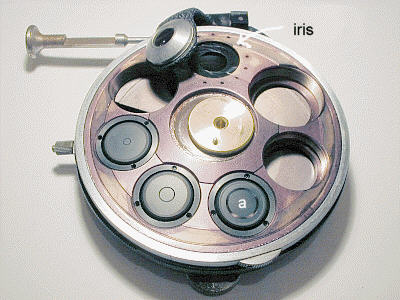 |
| This is a Zeiss phase
condenser with the top cover
removed for clarity. Notice the 7 apertures, 3 for the phase annuli such at 'A', 3 spare for user experimentation, and the all important brightfield aperture. All that is required is that the disc be turned to use the appropriate aperture. |
2) Observing in brightfield or phase requires only the substage to be adjusted, thus the phase objective is perfectly capable of yielding quality imagery in brightfield too. Theoretically the circular annuli inside phase objectives will mar the image quality in brightfield, but this is so small an effect that it can be genuinely ignored. Non phase objectives therefore are not required on the phase microscope to observe in brightfield or darkfield.3) The substage condenser in commonly available phase instruments is usually of Abbe form and serves phase and brightfield equally well. You might see a battery of phase objectives which includes the x 100 oil immersion, yet the maximum aperture of the condenser might be about 0.9 na. In phase configuration this apparent limiting of NA for the x100 oil lens is not such an impediment, because phase contrast enhancement is at work. When used in brightfield however, this limiting aperture of 0.9 na is noticeable as it would be through any brightfield 'scope.
Adjusting Phase Facilities
In use, phase requires that the observer must be aware of the alignment of the annuli in the substage and objective. This requires a 'focussing telescope' which temporarily replaces an eyepiece so that the annuli in the substage can be aligned with the objective, which takes only seconds to accomplish.
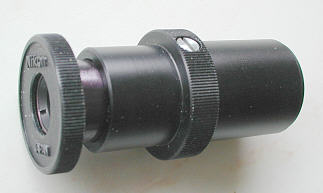 |
|
|
Telescope view of annuli :-
 |
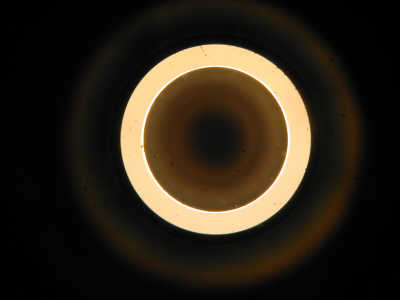 |
| Misaligned annuli | Aligned |
Lastly, the condenser's vertical placement may need to be changed to make sure that the substage annulus does not overlap the objective's :-
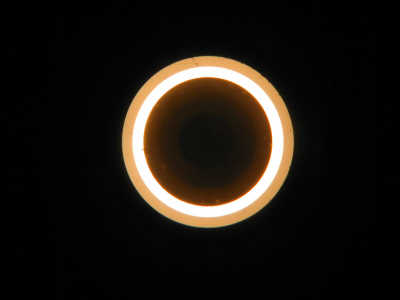 |
|
but condenser needs raising or lowering |
Phase in UseThose seeking a little assistance when searching for protoplasmic life in pond water will enjoy the benefits of phase contrast. Added to this is the convenience of being able to switch from brightfield to phase in a few seconds, thus allowing the observer the luxury of being able to choose the best viewing technique to suit the subject matter in hand.
Phase contrast is not a perfect solution to contrast enhancement, as Differential Interference Contrast ( DIC ) is arguably superior, but at a greater cost to the amateur. Phase contrast is however a relatively simple technique in actual use, and being also commonly available, it ranks as the contender for improving contrast for the amateur.
Here are 2 images to show the effects of phase contrast in entirely different situations :-
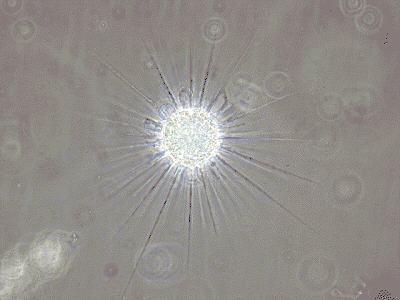 |
|
rendering of radial axils. |
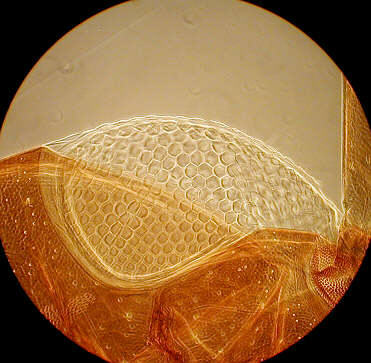 |
|
Phase used here to reveal lenses. |
SummaryWithout doubt phase contrast is a significant aid to image making in the microscope, and the real decision about whether to invest in this is ultimately a financial one.
| All comments to the author Paul James are welcomed |
Please
report any Web problems or offer general comments to the Micscape
Editor,
via
the contact on current Micscape Index.
Micscape
is the on-line monthly magazine of the Microscopy UK web
site
at Microscopy-UK